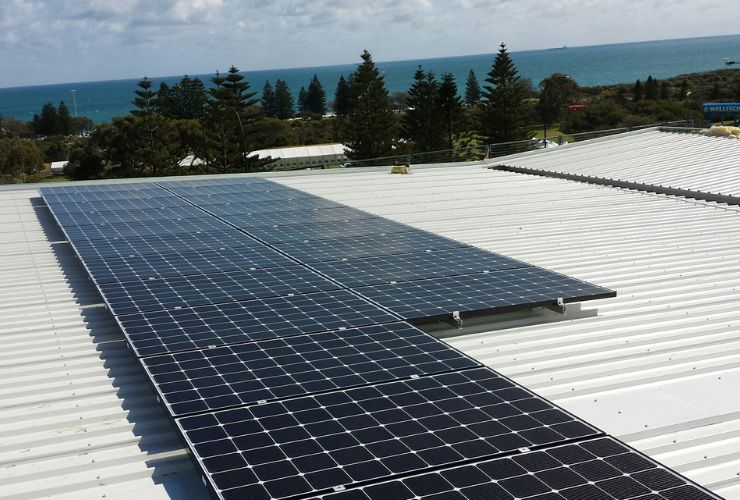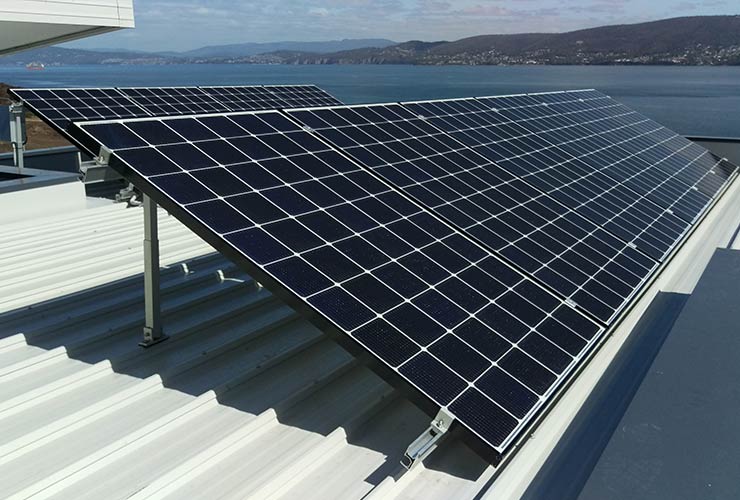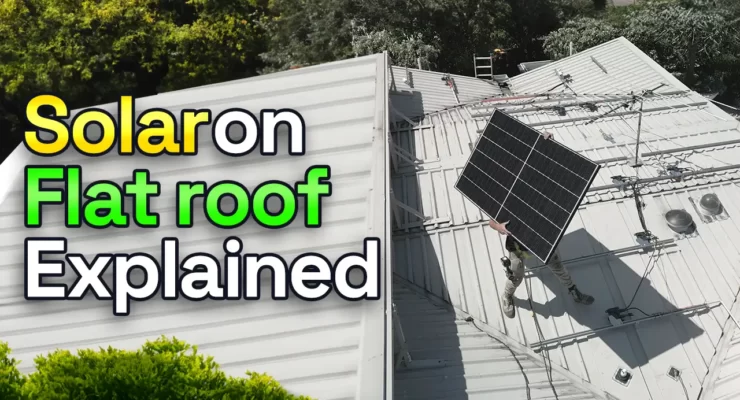Fast read
Solar panels can be effectively installed on flat roofs using standard or tilted framing. Ideally, panels should tilt towards the sun, based on the location's latitude, for optimal efficiency.
For instance, Sydney requires a 33° tilt. While panels can be flush-mounted on flat roofs, this approach risks reduced energy generation, increased maintenance, and potential degradation, and could void warranties. Tilted installations use frames or "tilt legs" to raise panels, enhancing solar exposure and improving energy output.
However, the wind load on tilted panels needs consideration, and structural integrity checks are essential. Before installing, consult a professional solar installer to assess the roof and recommend a suitable method. For solar and related products, it's advisable to work with experienced, reputable suppliers or installers to ensure both the system's efficiency and longevity.
Can we install solar on a flat roof?
Solar panels can be easily installed on a flat roof. The racking used is similar to the one on a pitched roof which would mean the site flat on the roof, or they can also be installed on an angle as in the picture below – in which case specialised tilt framing is used.
Solar panels work most efficiently when they are tilted to face the sun more directly. The best angle for the panels is the same as the latitude angle of where they are being installed.
So in Sydney, this is 33⁰, Brisbane 27⁰, Melbourne 37⁰, Perth 31⁰ etc. In Australia, most roofs have a pitch of around 22⁰. This means that solar panels can be installed on different types of roofs such as flat roofs without needing to adjust their tilt.
Standard installation on angled roofs
On pitched roofs, brackets are fixed to roof screws on Colorbond roofs or screwed to roof battens on tile roofs. Then, parallel rails are connected to these brackets along the roof surface. The solar panels can then be placed and clamped down onto the rail with 4 clamps.
Recommended installation on a flat roof
On a flat roof, the easiest and fastest way solar panels can be installed is the same way as above on the roof flat to the roof surface. However, this will result in a relatively flat installation, which can have specific consequences. They are:

If installed flat on the roof, it will generate about 13% less energy per year compared to a tilted installation. Winter generation will be especially lower due to the low angle of the sun on the panels.
Seasonal variation in solar PV system generation is increased with higher performance in peak summer. If the installation is tilted, a smaller system can be used. The tilted rows need space between them to prevent overshadowing during certain times of the day.
Installing solar panels flat on the roof instead of using a tilted frame can result in a 30% larger system. However, the output may decrease by 13%.
Despite this decrease, the overall electricity generation will still be greater with a flat-on-roof installation. However, the output may decrease by 13%.
Despite this, the overall electricity generation will still be greater with a flat-on-roof installation. Also tilted installs will take longer and cost more. So one needs to weigh up the options.
Tilted panels allow for the runoff of rainwater, which cleans a lot of the dust and grime off the panels. Flat installations will require some increased maintenance and cleaning, as the dust will settle a little more. This is not a major issue if the installation area receives a lot of rain, but can increase cleaning costs in dry and dusty areas.
Any other issues?
- Flat panels on the roof can sag in the middle, depending on the build of the panel. This sagging can see increased pooling of water which can create a risk of Potential Induced Degradation (PID). As well as shading and hotspots created by dust and dirt build-up on the panel glass. Nevertheless as said above some regular maintenance reduces these risks.
- Some solar panel models have a minimum tilt recommended by the manufacturer. If this minimum is not met for those specific models, the panel’s warranty may be voided.
How is the framing installed on tilt panels?
The other way to install the panels is by using framing to tilt the panels up on the roof to face the sun. This is similar to placing the panels flat above. However, it is typically accomplished by attaching “tilt legs” to the rail brackets beneath the panel. This can be seen in the photo.
This will raise the modules off the roof surface. The front edge is kept close to the roof surface while the rear edge is lifted up to tilt the panel. Below is the installation process:
- Roof Assessment: Like flush-mounted systems, the roof is assessed to ensure its structural capacity meets the requirements.
- Mounting Structure: The mounting structure consists of long and short tilted legs designed to hold the solar panels at an optimal angle. These racks/legs are attached to the roof using appropriate fasteners and techniques.
- Panel Installation: Solar panels are then mounted onto the tilted racks or frames and secured with suitable clamps/brackets.
- Electrical Connections: The wiring and electrical components are installed and UV-resistant conduits run, connecting the solar panels to the home’s electrical system.

What else to consider
Tilted racking systems maximise solar exposure, increasing energy production compared to flush-mounted systems. The tilt angle can be adjusted based on the desired energy output and local geographical factors. It’s important to think about the extra wind load from tilted panels and make sure the roof can handle it. On the downside the installed system capacity will be reduced and installation costs can be higher.
Placing the panels flat on the roof makes them less visible from the ground. This can be visually beneficial in certain cases.
Both parallel and tilted installations as rooftop solar methods have pros and cons, and both options are feasible. As panels get cheaper, the flat-on-the-roof method is used more often, especially for commercial solar installations.
Before proceeding with any residential solar installation, it’s advisable to consult with a professional solar installer. They can then evaluate your specific roof, its structural integrity, local regulations, and your energy needs. These experts can recommend the most suitable installation method and design a system that optimises energy production. They can also consider the aesthetics and long-term performance of your roof.



